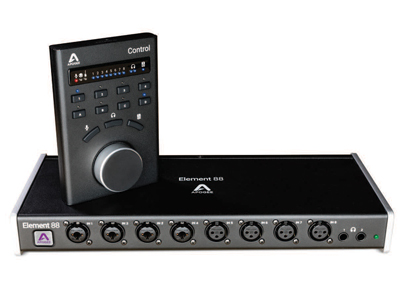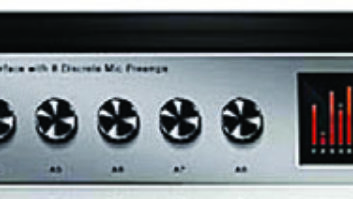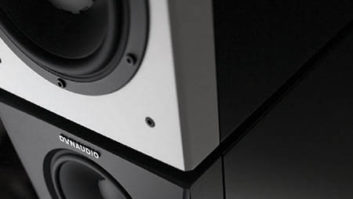
Last year I reviewed the Apogee Ensemble, a well-thought-out, feature-packed Thunderbolt 2 interface. The Element Series was designed to take this even further, incorporating analog components on par with those of the Ensemble, an improved software mixer, and a price that targets engineers and musicians for whom the elite Apogee line may have been just out of reach.
On the front panel are eight Neutrik input connectors—four XLR/ TRS combo jacks, able to accept mic, line or instrument-level signals, and four standard XLRs—a pair of headphone jacks and a power indicator. That’s it. The back is similarly simple, having a pair of XLR outputs, a pair of ¼-inch TRS auxiliary outputs, and two pairs of TOSLINK connectors (two for input, two for output). These optical connectors allow a maximum of eight inputs and eight outputs but are doubled to allow this full I/O count at SMUX 24-bit/96kHz rates. Power, wordclock I/O and a single Thunderbolt connector complete the back panel.
Unlike most all-in-one interfaces, there are no buttons, switches or knobs on the interface itself. Likewise, there is no display, nor are there meters, or even signal indicator lights, apart from power. But there is a new proprietary software mixer, Element Control, and an Ensemble and an Element can be ganged together on one system, just as two Elements can be combined through the software.
Overall, the Element Control software features slicker and more modern-looking graphics than the old Maestro software. There is a higher degree of customizability, as well, with a handful of useful templates to point the way. On the left side of the application are nitty-gritty settings like sample rate, clock source, and choices of digital output types, meters, etc.
The main part of the Element Control interface features the input controls and monitoring mixers. In the most basic configuration, software outputs can be fed directly to hardware outputs, and given the low-latency Thunderbolt connection, this is often feasible. When sessions grow, Pro Tools buffer settings are increased, latency grows, and low-latency input monitoring becomes necessary. For this, the Element control software allows the creation of up to four separate monitoring mixes; each can be fed to any output or combination of outputs.
When building these mixes, there are a few points of convenience. For one, the main mixer features large faders, while each subsequent aux mixer features smaller faders and scaled back controls. This helps by minimizing the amount of necessary vertical scrolling, if any. To further
this, any aux mixer that is not being used can be hidden from view. Similarly, any input, analog or digital, as well as any of the six pairs of DAW returns can be hidden. If more I/O is put to use, items can be re- turned to the mixer without causing interruptions in playback.
Residing at the top of the interface, inline with the corresponding channels, there are meters for any signal feeding the mixer. Below these, on analog input channels, input type selection, gain, and other tools like HPF, soft-limiting, and phantom power can be engaged.
For those who desire the tactile control of hardware buttons and knobs, Apogee offers an optional hardware controller called the Apogee Control, which attaches directly to a USB port on the host computer. It features a well-built rotary encoder with an integrated soft-button, and three mode buttons to toggle its operation between input gain, monitor level and headphone level. Eight more soft-keys, grouped into two rows of four, are completely customizable. About 25 different functions can be assigned to the Control’s soft-keys, ranging from predictable things like monitor dim, engaging phantom power for a selected input, or clearing meter peaks, to a few more advanced operations.
For instance, any custom key could be used to engage momentary or latching talkback using the MacBook’s built-in microphone. Another handy macro was a mute toggle for those recording themselves or working in the same room as the artist. When tracking, monitors could be muted, while un-muting the headphones, via a single button press. Another press reverses this.
One of my favorite things about the Element Control software is the way it acknowledges a single-screen workflow. I would typically run the Element Control as a full-screen app and have Pro Tools on a separate “space” using OSX Sierra’s virtual desktop feature. This meant flipping back and forth between the Pro Tools space and Element Control space during tracking. Until I discovered the Essentials window.
The Essentials window took all of the input and monitor output controls and placed them on one narrow strip. While control of the submixes resided solely in the full Control window, everything needed at a moment’s notice was accessible—oriented vertically or horizontally, taking up a minimal amount of real estate on the screen. When tracking, the Essentials window sat on the top of my screen just above the active Pro Tools window. This was extremely handy. While Logic X can directly control the Element’s mic preamps from within the software, this was certainly a next best thing.
My only complaint about this workflow was that clicking on a preamp made the Element Control the active application, forcing me to tab back to Pro Tools to stop the transport with a press of the spacebar. It was frustrating if I forgot to tab back, because it all feels like one large application.
I used the Element 88 with MacBook Pro running OSX 10.12.3 and primarily with Pro Tools 12.7.1. I spent a good amount of time getting familiar with the D/A converters and software before using it for tracking. The overall sound of the Element 88 wasdefinitely reminiscent of the Apogee Ensemble—clear, detailed and modern. There was no hype, just a punchy, honest and complete depiction of the source.
One of my favorite sounds captured with the Element 88 was a stereo recording of an acoustic guitar. Using an ORTF pair of small-diaphragm condensers, the realism of the stereo field was impeccable. The foundation of the song was a drum loop, which came across as fairly mono, so a piano and the acoustic guitar had to fill out the sides. The recording setup, along with the detail captured by the Element’s front end, did a great job in the width department. There was also a clear, focused center that I could steer across the stereo image by slightly moving the mics, so the focal point of the guitar could sit just outside the centered vocal, with the overall sound of the instrument creating a large and immersive image.
Plugging a bass into the DI input of the Element 88 produced another very nice recording. The tricky thing about using DIs that are integrated into interfaces is that headroom often comes at the cost of tone. In many cases, turning down the input enough for an artist to perform comfortably without any chance of clipping places the signal at a thin-sounding point of the mic preamp’s electronics. This never seemed to be the case with the Element 88’s DI inputs. I could turn down the input, leaving generous headroom, and the device’s input always seemed to perform with the same full bottom end and crisp top end.
When it came to overdubbing, building artist mixes of Pro Tools returns plus live, low-latency inputs was easy and convenient, once I got the hang of it. Like the Ensemble, the Element coordinates with the I/O settings in Pro Tools to correctly identify analog vs. digital inputs, and physical outputs vs. software returns to the Element Control’s mixer. Given that Pro Tools 12 is more obtrusive than previous versions of the DAW when it comes to I/O settings, it was important to frequently check this, and make sure to “default” the I/O settings tabs to ensure that this stayed accurate. That’s nothing against the interface; it’s just a reality of the new Pro Tools. Again, Apogee has created an interface full of slick innovations that blur the line between their software, the OS and the DAW. The Element Control software is a powerful next step from Maestro, and the Control USB is so slick that it will likely be copied by every other interface manufacturer.
The preamps and converters are top-notch, and the smart design of the Control software can’t be overstated. If you’re looking for a tracking interface, Element 88 brings great sound and convenience, and despite being affordable, should still be taken very seriously.




